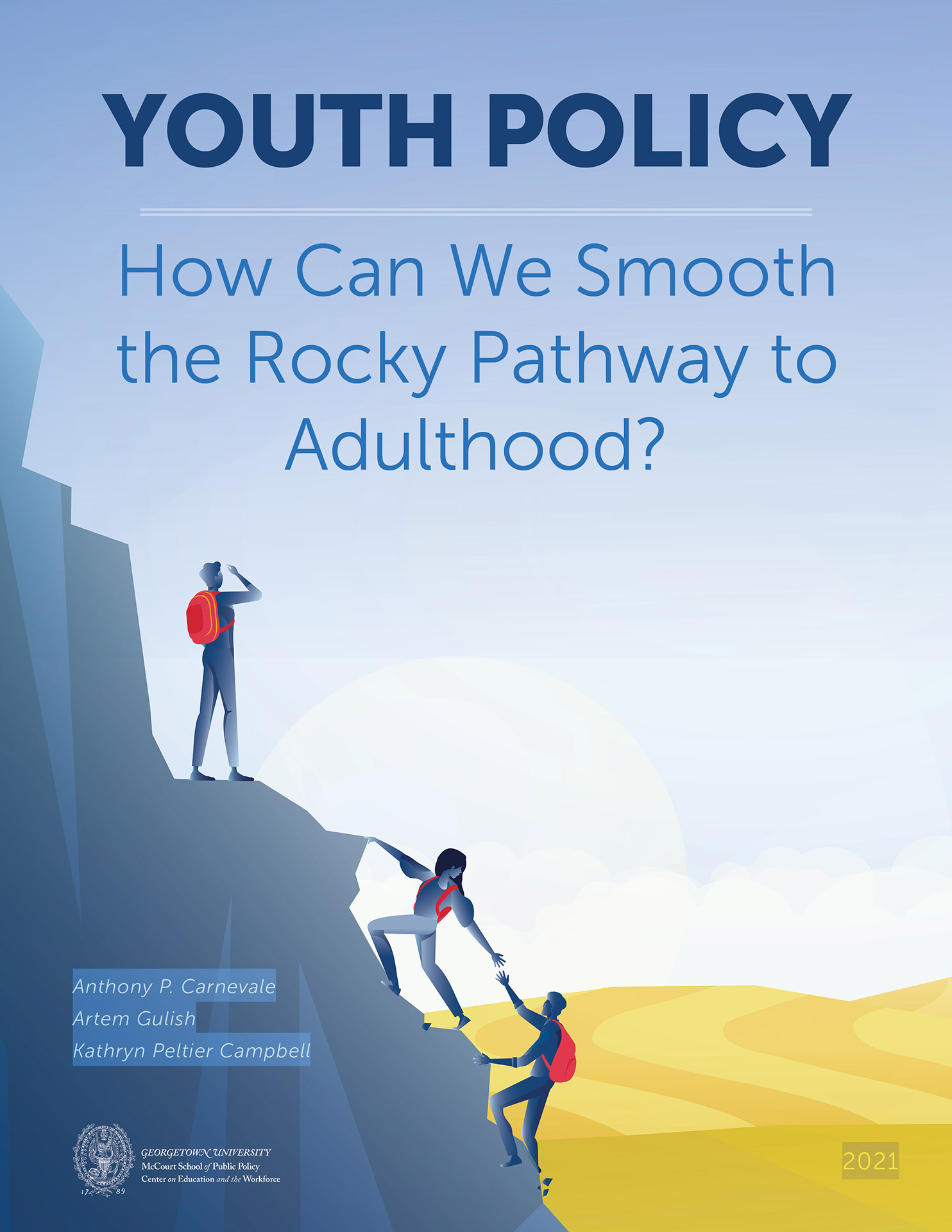Youth Policy
How Can We Smooth the Rocky Pathway to Adulthood?
Summary
While boosts in labor demand have helped young workers as the economy recovers from the COVID-19 recession, young people continue to grapple with a youth labor market that has been deteriorating for 20 years. Their prospects have been dimmed by three major recessions: the burst of the dot-com bubble (2001), the Great Recession (2007-2009), and the COVID-19 recession (2020). Further, long-term structural changes in the economy have favored older workers with more experience, training, and education while limiting opportunity for young workers.
Youth Policy: How Can We Smooth the Rocky Pathway to Adulthood? examines the United States’ fragmented and inadequate approach to youth policy against the backdrop of these economic pressures and recommends changes necessary to move toward a more comprehensive and holistic approach.
Youth Employment Has Declined during the Past 20 Years
By the end of 2019, youth (ages 16 to 21) were already 11 percentage points less likely to be employed than in 2000, compared to a 1-percentage-point difference for prime-age adults (ages 25 to 54). During the pandemic, the youth employment rate declined by another 6 percentage points, and the gap between youth employment and prime-age employment has widened by 9 percentage points since 2000. Some of the decline in youth employment rates can be attributed to an increase in the share of youth enrolled in school or college, which was 59 percent in 2000 and has been over 65 percent since 2012.

Source: Georgetown University Center on Education and the Workforce analysis of data from the US Census Bureau and Bureau of Labor Statistics, Current Population Survey (CPS), Basic Monthly, 2000–21.
Note: The figure shows the change in the employment-to-population ratios since December 2000, using a 12-month trailing moving average. The shaded areas indicate recessions based on official National Bureau of Economic Research (NBER) dates.

Black/African American and Hispanic/Latino Youth are Much More Likely to be Disconnected from School and Work than White Youth
The overall share of youth who are disconnected—neither working nor enrolled in school—rose during the COVID-19 downturn, reaching 16 percent by March 2021 before dropping back to 14 percent by June 2021. The overall rate of disconnection from school and work hides major disparities by race and ethnicity: Black/African American and Hispanic/Latino youth are substantially more likely to be neither working nor enrolled in school or college than White youth.
Source: Georgetown University Center on Education and the Workforce analysis of data from the US Census Bureau and Bureau of Labor Statistics, Current Population Survey (CPS), Basic Monthly, 2000–21.
Note: This figure shows the share of youth by race/ethnicity who are neither employed nor enrolled in school, based on a 12-month trailing moving average. Before 2003, the Current Population Survey combined the Pacific Islander and Asian race/ethnicity groups. The shaded areas indicate recessions based on official National Bureau of Economic Research (NBER) dates.
For Young Adults, More Education Is Key to Labor Market Success
Young adults (ages 22 to 27) with graduate and professional degrees have a higher employment-to-population ratio than similarly educated young adults had in 2000. All other groups of young adults have lower employment rates now than similarly educated young adults did in 2000.

Source: Georgetown University Center on Education and the Workforce analysis of data from the US Census Bureau and Bureau of Labor Statistics, Current Population Survey (CPS), Basic Monthly, 2000–20.
Note: The figure shows the change in the employment-to-population ratios from 2000, using a 12-month trailing moving average. The shaded areas indicate recessions based on official National Bureau of Economic Research (NBER) dates.
The United States Needs a Comprehensive Approach to Youth Policy
These trends illustrate the urgent need for comprehensive reform of the youth policy landscape. Youth policy in the United States is a vast patchwork quilt of programs, initiatives, and funding streams. It is fragmented across multiple institutional silos—including K–12 education; postsecondary education; federal, state, and local government entities; and private industry. This disjointed and fragmented approach to youth policy allows too many young people to slip through the seams.
Most youth programs in the United States are administered at the state and local levels, although many receive federal funding. Many programs have become more decentralized over the years. For example, youth employment and training policy traces its roots to the New Deal, a national response to the Great Depression, but subsequent legislation has established more state and local control over youth employment and training programs. These programs have also suffered from decades of underinvestment.
On the education front, federal legislation serves as an umbrella for many state and local policies and programs. Education policy is further fragmented into K–12 and postsecondary silos.
An all-one-system approach to youth policy would support young people along the entire continuum of their journey from school to work. It would help them attain both postsecondary education and quality work experience to support their transitions from education to good jobs. In this modernized approach, preschools, elementary and secondary schools, community colleges, four-year universities, employers, and governments would all follow an integrated playbook, helping to smooth out young people’s path from pre-K–12 to college and work. To transform youth policy, systemic reforms should incorporate the following:
- universal access to publicly funded early childhood education
- equitable funding for K–12 and postsecondary education
- career development starting in middle school
- improved availability and usability of data
- enhanced academic and career counseling
- vigorous commitment to equal opportunity regardless of race, ethnicity, class, and gender
- improved transfer policy
- more flexible education and career pathways that ensure students receive credit for prior learning
Resources
Youth Policy: How Can We Smooth the Rocky Pathway to Adulthood? examines the United States’ fragmented and inadequate approach to youth policy against the backdrop of economic pressures facing youth and young adults today.

